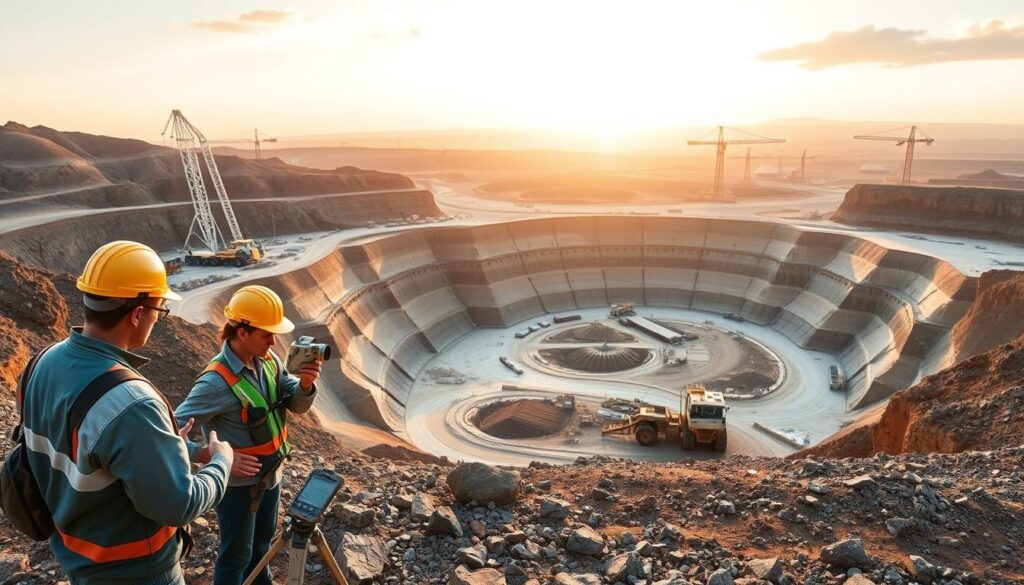Embark on a thrilling journey into the world of mining and geological engineering, where the extraction of valuable minerals and resources meets innovative technology.
This dynamic field combines earth sciences and mineral extraction techniques to uncover the secrets of the earth, providing a foundation for a rewarding career.
With a strong focus on geological engineering, professionals in this field are equipped to tackle complex challenges, from resource exploration to environmental sustainability.
Key Takeaways
- Explore the exciting field of mining and geological engineering
- Discover the importance of earth sciences in mineral extraction
- Learn about the career opportunities available in this dynamic field
- Understand the role of geological engineering in resource exploration
- Uncover the potential for environmental sustainability in mining and geological engineering
What is Mining and Geological Engineering?
The field of Mining and Geological Engineering encompasses a broad range of disciplines focused on the exploration, extraction, and management of the Earth’s resources. It is an interdisciplinary field that draws on knowledge from geology, physics, mathematics, and engineering to develop solutions for the extraction of minerals, oil, and gas.
Defining the Field
Mining and Geological Engineering is characterized by its focus on the application of scientific and engineering principles to the extraction and management of earth resources. This involves understanding the geological context of mineral deposits and applying advanced engineering techniques to extract these resources efficiently and safely.
Key Disciplines and Focus Areas
The field encompasses several key disciplines, including geotechnical engineering, which deals with the behavior of earth materials, and mineral processing, which involves the extraction of valuable minerals from ore. Other focus areas include rock mechanics and earth resource management, both critical for the sustainable exploitation of mineral resources.
Relationship to Earth Sciences
Mining and Geological Engineering is closely related to earth sciences, as it relies heavily on geological knowledge to understand the distribution and characteristics of mineral deposits. The field integrates principles from geology, geophysics, and geochemistry to inform exploration and extraction activities.
The Intersection of Science and Engineering
At the heart of Mining and Geological Engineering is the intersection of science and engineering. By combining scientific knowledge of the Earth’s systems with engineering expertise, professionals in this field can develop innovative solutions to the challenges of resource extraction. This includes the application of mining technology to improve efficiency and reduce environmental impact.
Core Principles and Objectives
The core principles of Mining and Geological Engineering include a commitment to safety, environmental stewardship, and economic viability. The objectives of the field are to extract resources in a manner that is safe for workers, minimizes environmental harm, and is economically sustainable. Achieving these objectives requires a deep understanding of both the geological context and the engineering techniques used in resource extraction.
The Evolution of Mining and Geological Engineering
From ancient civilizations to modern times, the evolution of mining and geological engineering has been shaped by human needs and technological innovations. The field has come a long way, transforming the way we extract minerals and manage the earth’s resources.
Historical Development
The history of mining and geological engineering dates back thousands of years, with early civilizations extracting resources for tools, currency, and other essential needs. As societies grew, so did the complexity of mining operations, leading to the development of more sophisticated techniques and technologies.
Modern Advancements
Today, the mining industry is characterized by significant advancements in technology, including automation, digital modeling, and remote sensing. These innovations have improved the efficiency and safety of minerals extraction, while also reducing environmental impacts.
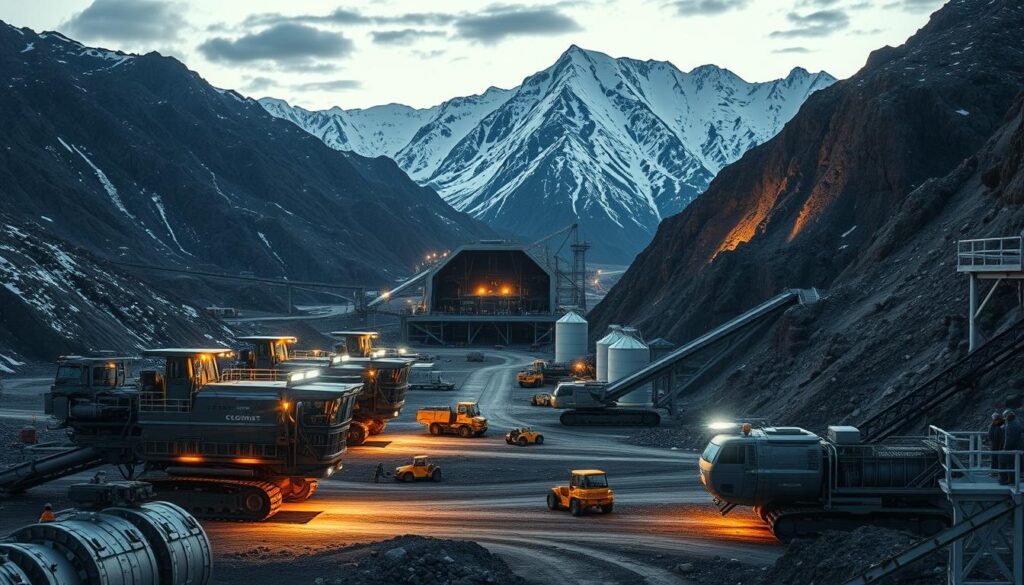
Industry Transformation
The industry is undergoing a transformation, driven by the need for environmental sustainability and the integration of new technologies. Geotechnical engineers play a crucial role in this process, ensuring that mining operations are safe, efficient, and environmentally responsible. As the demand for minerals continues to grow, the field of mineral exploration is also evolving, with a focus on discovering new resources while minimizing environmental footprint.
Educational Pathways to Success
Educational pathways play a crucial role in shaping the careers of Mining and Geological Engineers. A comprehensive education in this field not only provides a solid foundation in the principles of mining and geological engineering but also equips students with the skills necessary to tackle complex challenges in the industry.
Undergraduate Programs
Undergraduate programs in Mining and Geological Engineering are designed to provide students with a broad understanding of the field, including mining education and geotechnical analysis. Essential coursework typically includes:
- Mine planning and design
- Geological surveys
- Environmental impacts of mining
- Geotechnical engineering
Hands-on Experience Requirements
Hands-on experience is a critical component of undergraduate programs. Students are often required to participate in internships or co-op programs to gain practical experience in the field.
Graduate Opportunities
For those looking to specialize further, graduate programs offer advanced degrees in areas such as mine planning and design, geotechnical analysis, and environmental management.
Top Mining and Geological Engineering Schools in the US
Some of the top schools in the US for Mining and Geological Engineering include:
- Colorado School of Mines
- Michigan Technological University
- University of Arizona
Internships and Co-op Programs
Internships and co-op programs provide valuable work experience, allowing students to apply theoretical knowledge in real-world settings.
By pursuing these educational pathways, individuals can set themselves up for success in the Mining and Geological Engineering field, equipped with the knowledge, skills, and experience necessary to excel.
Core Skills for Mining and Geological Engineers
To succeed in Mining and Geological Engineering, professionals must possess a distinct set of skills that blend technical knowledge with practical application. These skills are crucial for navigating the complexities of the field and driving success in various mining and geological engineering careers.
Technical Competencies
Technical competencies form the backbone of a Mining and Geological Engineer’s skill set. Proficiency in specific software and technologies is essential for data analysis, modeling, and simulation.
Software and Technology Proficiency
Engineers must be adept at using industry-standard software such as GEOVIA, Surpac, and Datamine for geological modeling and mine planning. Familiarity with AutoCAD and GIS technology is also valuable for mapping and spatial analysis.
Field Skills
Field skills are equally important, as they enable engineers to conduct site assessments, collect data, and implement their designs effectively. Skills in geological mapping, sampling, and exploration techniques are vital for identifying mineral resources and understanding geological structures.
Analytical Abilities
Strong analytical abilities are critical for interpreting complex data, assessing risks, and making informed decisions. Mining and Geological Engineers must be able to analyze geological data, mine design plans, and operational metrics to optimize performance and ensure safety.
Soft Skills for Industry Success
Beyond technical skills, soft skills play a significant role in the success of Mining and Geological Engineers. Effective communication, teamwork, and problem-solving abilities are essential for collaborating with multidisciplinary teams and managing projects. As the industry evolves, engineers with strong soft skills are better positioned to adapt to new challenges and opportunities, potentially leading to better career advancement and higher geological engineering salary prospects.
To develop these skills, aspiring engineers can look into programs offered by top mining schools, which provide comprehensive education and training in Mining and Geological Engineering.
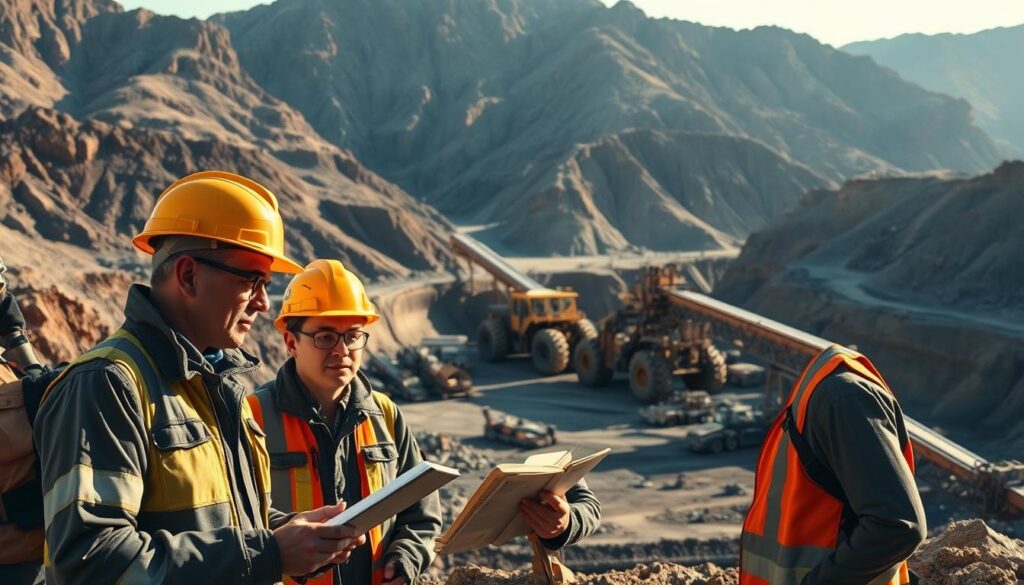
Specializations Within Mining and Geological Engineering
The specializations within Mining and Geological Engineering are fundamental to the development and implementation of effective mining practices. This diverse field encompasses several key areas of expertise, each playing a vital role in the extraction and processing of mineral resources.
Mineral Exploration
Mineral exploration is a critical specialization that involves the search for and identification of mineral deposits. This process utilizes various techniques, including geological mapping, geochemical sampling, and geophysical surveys, to locate potential mining sites.
Mine Design and Planning
Mine design and planning are essential for the efficient and safe extraction of minerals. This specialization requires a deep understanding of mining methods, equipment selection, and operational logistics to optimize mine performance.
Geotechnical Engineering
Geotechnical engineering in mining involves the application of geological principles to understand the behavior of rock and soil. This knowledge is crucial for designing stable mine structures and preventing hazards such as rockfalls.
Mineral Processing
Mineral processing is the specialization focused on extracting valuable minerals from ore. This involves various techniques, including crushing, grinding, and flotation, to produce high-quality mineral concentrates.
Environmental Management
Environmental management is a vital specialization that addresses the ecological impacts of mining activities. It involves developing strategies to minimize environmental footprint, manage waste, and rehabilitate mined lands.
| Specialization | Description | Key Activities |
|---|---|---|
| Mineral Exploration | Identifying mineral deposits | Geological mapping, geochemical sampling |
| Mine Design and Planning | Optimizing mine operations | Mine planning, equipment selection |
| Geotechnical Engineering | Ensuring mine stability | Rock mechanics, soil analysis |
| Mineral Processing | Extracting valuable minerals | Crushing, grinding, flotation |
| Environmental Management | Minimizing environmental impact | Waste management, land rehabilitation |
In conclusion, the specializations within Mining and Geological Engineering are interconnected and crucial for the sustainable development of mineral resources. By understanding and advancing these specializations, professionals in the field can contribute to more efficient, safe, and environmentally responsible mining practices.
Career Opportunities in the Mining Industry
Mining and geological engineering careers span a broad spectrum of roles, each contributing to the extraction and management of mineral resources. The industry’s diverse needs create a wide range of opportunities for professionals with different skills and interests.
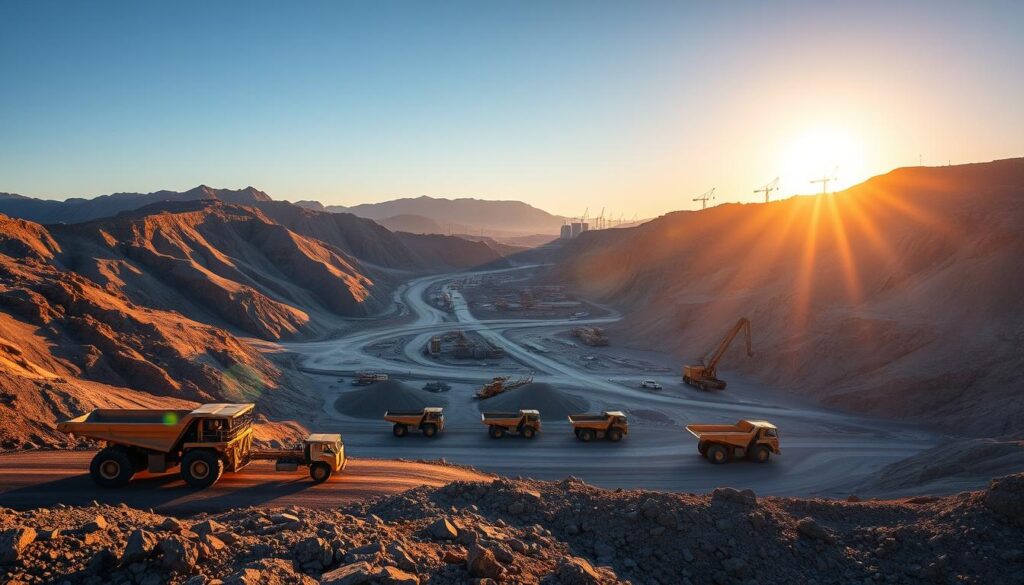
Entry-Level Positions
Entry-level positions in the mining industry often involve roles such as mining engineering assistants, geological technicians, or environmental monitoring specialists. These roles provide foundational experience in rock mechanics, geological surveying, and environmental management.
Mid-Career Roles
As professionals gain experience, they can move into mid-career roles such as mine planning engineers, senior geological technicians, or project managers. These positions require a deeper understanding of mining projects and the ability to oversee complex operations.
Senior and Executive Opportunities
Senior and executive roles in the mining industry include positions like mine general managers, directors of geological operations, or chief operating officers. These individuals are responsible for strategic decision-making, often involving geological modeling and resource management.
Consulting and Entrepreneurship
Experienced professionals may choose to start their own consulting firms or venture into entrepreneurship, offering specialized services such as environmental impact assessments or mineral resources evaluation.
Starting Your Own Firm
Starting a consulting firm in the mining industry requires a strong network, expertise in a specific area, and a solid business plan. It involves providing valuable services to mining companies, such as geotechnical analysis or operational efficiency improvements.
Specialized Consulting Services
Specialized consulting services can range from geological surveying to mine design and planning. These services are crucial for mining companies looking to optimize their operations and comply with environmental regulations.
A Day in the Life of Mining and Geological Engineers
The work of mining and geological engineers encompasses a wide range of responsibilities, from mine planning to environmental management. Their role is crucial in ensuring the sustainability and safety of mining operations.
Field Work Responsibilities
Mining and geological engineers often work in the field, overseeing mining operations and conducting site inspections to ensure compliance with mine safety practices. They may also be involved in resource management, identifying new mineral deposits and assessing the quality of existing resources.
Office and Laboratory Tasks
In addition to field work, these engineers spend time in offices and laboratories, analyzing data, designing mine plans, and conducting experiments to improve mining techniques. They use specialized software for mine planning and resource estimation.
Project Management Duties
Mining and geological engineers are often responsible for managing projects, ensuring they are completed on time and within budget. This involves coordinating with other professionals, such as geologists and miners, to achieve project goals.
Work-Life Balance Considerations
The job can be demanding, with long hours and time spent away from home. However, many mining and geological engineers find the work rewarding and enjoy a good work-life balance. They must also consider mining sustainability practices to minimize environmental impact.
Key responsibilities include:
- Overseeing mining operations
- Conducting site inspections
- Managing projects
- Analyzing data and designing mine plans
Mining Engineering: Focus on Extraction and Operations
The discipline of mining engineering is centered around the principles of extraction and operational efficiency. It involves the application of various techniques and technologies to extract valuable resources from the earth while ensuring safety and minimizing environmental impact.
Surface Mining Techniques
Surface mining techniques are used to extract resources from the earth’s surface. These methods include open-pit mining, quarrying, and placer mining. The choice of technique depends on the type of resource, terrain, and environmental considerations.
Underground Mining Methods
Underground mining methods are employed when resources are located beneath the earth’s surface. Techniques such as room and pillar mining, longwall mining, and sublevel caving are used. These methods require careful planning and execution to ensure safety and efficiency.
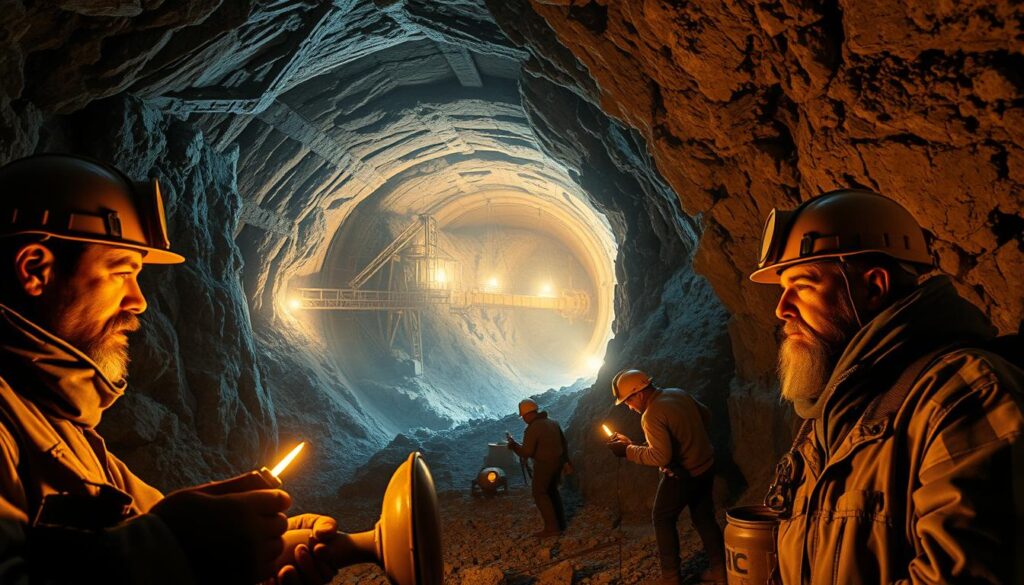
Mine Safety and Regulations
Mine safety is a critical aspect of mining engineering. Regulations are in place to protect workers and the environment.
Safety Protocols
Safety protocols include regular training, equipment maintenance, and emergency preparedness plans. These measures help prevent accidents and ensure a safe working environment.
Regulatory Compliance
Regulatory compliance involves adhering to laws and guidelines set by governing bodies. This includes environmental regulations, labor laws, and health and safety standards.
Operational Efficiency
Operational efficiency is crucial for the success of mining operations. It involves optimizing processes, reducing waste, and improving productivity. Techniques such as lean mining and advanced analytics are used to achieve operational efficiency.
| Technique | Description | Benefits |
|---|---|---|
| Open-pit mining | Extracting resources from a large pit | High production rates, cost-effective |
| Room and pillar mining | Extracting resources in a grid pattern | Safety, ground stability |
| Longwall mining | Extracting resources in a continuous panel | High recovery rates, efficiency |
“The future of mining engineering lies in its ability to balance resource extraction with environmental stewardship and social responsibility.”
Geological Engineering: Earth Analysis and Resource Management
Geological engineers are at the forefront of analyzing the earth’s structure and managing resources for future generations. Their work involves a deep understanding of the earth’s geology and the application of engineering principles to extract resources efficiently and safely.
Geological Mapping and Surveying
Geological mapping and surveying are critical components of geological engineering. These processes involve creating detailed maps of the earth’s surface and subsurface to identify potential mineral resources and understand geological structures. Advanced technologies such as GPS and GIS are used to enhance the accuracy of these maps.
Resource Estimation
Resource estimation is a key responsibility of geological engineers, involving the quantification of mineral resources and reserves. This process requires a thorough analysis of geological data, including drill hole samples and geophysical surveys, to estimate the quantity and quality of resources.
Site Characterization
Site characterization involves assessing the geological and geotechnical properties of a site to determine its suitability for mining or construction. Geological engineers use various techniques, including drilling and sampling, to gather data on the site’s conditions.
Geologic Hazard Assessment
Geologic hazard assessment is crucial for identifying potential risks associated with geological conditions, such as landslides, earthquakes, and subsidence. Geological engineers assess these hazards to develop strategies for mitigating their impact on mining operations and infrastructure.
| Geological Engineering Tasks | Description | Techniques Used |
|---|---|---|
| Geological Mapping | Creating detailed maps of the earth’s surface and subsurface | GPS, GIS, Remote Sensing |
| Resource Estimation | Quantifying mineral resources and reserves | Drill hole sampling, Geophysical surveys |
| Site Characterization | Assessing site conditions for mining or construction | Drilling, Sampling, Geotechnical testing |
By combining these tasks, geological engineers play a vital role in ensuring the safe and efficient extraction of mineral resources, while also mitigating potential geological hazards.
Environmental Considerations in Mining and Geological Engineering
Environmental concerns are at the forefront of mining and geological engineering, driving innovation and regulatory compliance. As the industry continues to evolve, it’s crucial to balance resource extraction with environmental stewardship.

Sustainable Mining Practices
Sustainable mining practices are becoming increasingly important as the industry seeks to minimize its environmental footprint. This includes adopting technologies that reduce waste and emissions, as well as implementing reclamation plans to restore mined lands.
- Reducing energy consumption through efficient equipment
- Implementing water conservation measures
- Minimizing land disturbance through careful planning
Environmental Impact Assessment
Conducting thorough environmental impact assessments is a critical step in the mining and geological engineering process. These assessments help identify potential risks and opportunities for mitigation.
“The goal of environmental impact assessment is to ensure that mining activities are carried out in a responsible manner, with due consideration for the potential impacts on the environment and local communities.”
Mine Reclamation and Closure
Mine reclamation and closure plans are essential for restoring sites after mining activities have ceased. This involves stabilizing the terrain, re-vegetating the area, and ensuring that the site is safe for future use.
Key aspects of mine reclamation include:
- Soil stabilization to prevent erosion
- Re-vegetation with native species
- Monitoring to ensure ecological recovery
Regulatory Compliance
Regulatory compliance is a critical aspect of environmental management in mining and geological engineering. This involves adhering to federal and state regulations, as well as industry best practices.
Federal Regulations
At the federal level, regulations such as the Clean Water Act and the National Environmental Policy Act (NEPA) provide a framework for environmental protection.
State-Specific Requirements
In addition to federal regulations, mining operations must also comply with state-specific requirements, which can vary significantly.
By prioritizing environmental considerations, the mining and geological engineering industries can reduce their environmental impact while maintaining operational efficiency.
Technological Advancements Transforming the Field
The mining and geological engineering sector is on the cusp of a technological revolution, driven by innovations that are transforming traditional practices. These advancements are not only enhancing operational efficiency but also improving safety and reducing environmental impact.
Automation and Robotics
Automation and robotics are playing an increasingly significant role in mining and geological engineering. Automated drilling and excavation systems are improving precision and reducing the need for human intervention in hazardous environments. Robotics is also being used for inspection and maintenance tasks, enhancing safety and reducing downtime.
Digital Modeling and Simulation
Digital modeling and simulation are revolutionizing the way mining and geological engineers design and optimize operations. Advanced software tools allow for the creation of detailed 3D models of mines and geological formations, enabling more accurate planning and simulation of various scenarios. This technology helps in optimizing resource extraction and minimizing environmental impact.
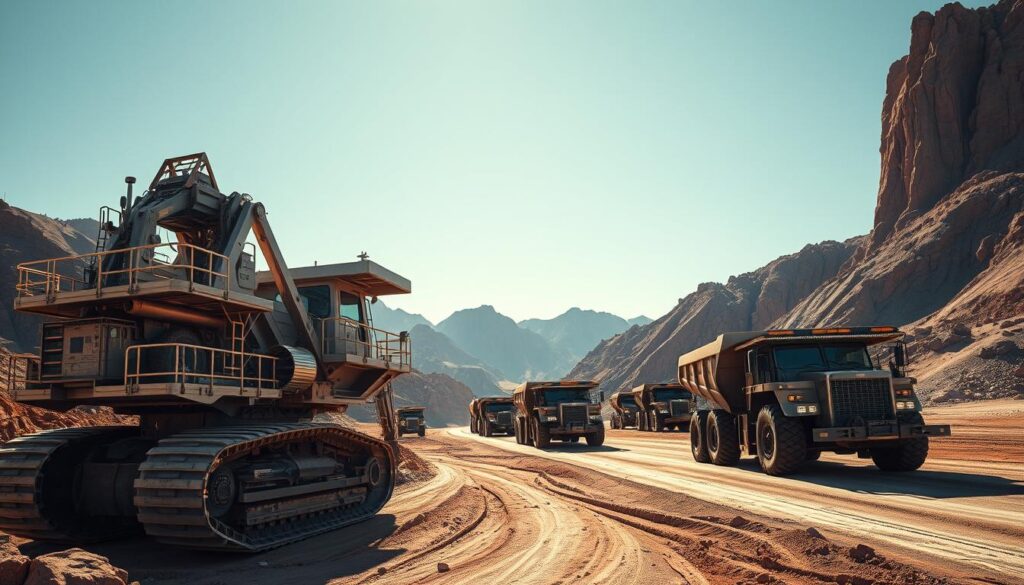
Remote Sensing and Monitoring
Remote sensing and monitoring technologies are being used to gather critical data on mining operations and geological formations. Satellite and drone-based sensors provide real-time information on environmental conditions, mine stability, and resource availability. This data is crucial for making informed decisions and ensuring compliance with mining regulations.
Data Analytics in Resource Management
Data analytics is transforming resource management in mining and geological engineering. By analyzing data from various sources, engineers can gain insights into operational efficiency, resource availability, and potential risks. Predictive analytics can help in forecasting equipment failures, optimizing ore processing, and improving overall productivity.
The integration of these technological advancements is set to continue transforming the mining and geological engineering field, offering new opportunities for growth and development in careers related to mining engineering and geological engineering degrees.
Salary Expectations and Job Outlook
Understanding the financial aspects of a career in Mining and Geological Engineering is crucial for prospective students and professionals. The field offers a range of compensation packages that vary based on experience, location, and industry trends.
Entry to Senior Level Compensation
Mining and Geological Engineers can expect competitive salaries, with entry-level positions starting around $65,000 to $80,000 annually. As professionals gain experience, their salaries can significantly increase, with senior-level engineers earning upwards of $150,000 or more per year.
Regional Variations in the US
The United States offers a diverse range of mining activities, from coal mining in Appalachia to gold mining in California. Consequently, salaries can vary significantly by region, with areas having high mining activity often offering higher compensation to attract and retain talent.
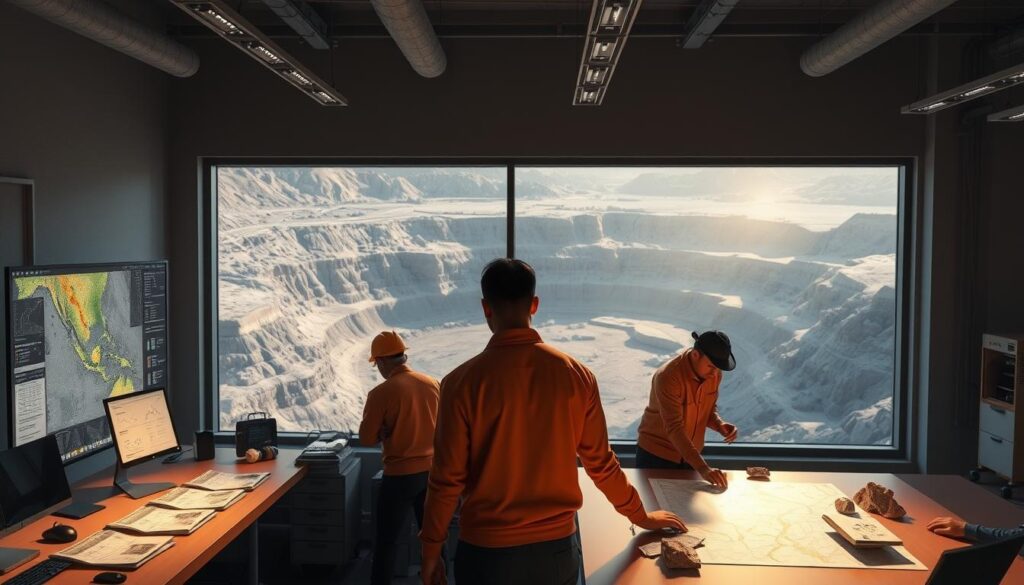
Growth Projections for the Industry
The job outlook for Mining and Geological Engineers is influenced by global demand for minerals and energy resources. While the industry faces challenges such as environmental concerns and market fluctuations, there is a steady demand for skilled engineers who can efficiently and sustainably manage mining operations.
Factors Affecting Earning Potential
Several factors can impact the earning potential of Mining and Geological Engineers, including level of education, certifications, and specific job roles. Engineers with advanced degrees or specialized certifications often command higher salaries. Additionally, working in certain sectors, such as oil and gas extraction, can lead to higher compensation compared to other mining sectors.
By understanding these factors and staying informed about industry trends, Mining and Geological Engineers can better navigate their career paths and maximize their earning potential.
Real-World Projects and Challenges
The practical aspects of mining and geological engineering are highlighted through various real-world projects and challenges. These projects not only showcase the complexity of the field but also demonstrate the innovative solutions that engineers implement to overcome obstacles.

Case Studies in Mining Engineering
Mining engineering projects often involve intricate planning and execution. Two significant areas of focus are successful mine development projects and challenging extraction scenarios.
Successful Mine Development Projects
Successful mine development projects are characterized by meticulous planning, advanced technology, and a deep understanding of geological conditions. For instance, the use of advanced exploration and drilling techniques has enabled mining companies to discover new mineral deposits and optimize extraction processes.
“The integration of technology in mining operations has revolutionized the way we approach mine development, making it more efficient and safer.” – Industry Expert
Challenging Extraction Scenarios
Challenging extraction scenarios require engineers to devise creative solutions. For example, extracting resources from complex geological formations demands a thorough understanding of geologic hazards and the application of sophisticated resource extraction methods.
Geological Engineering Success Stories
Geological engineering success stories often revolve around effective mapping and surveying, precise resource estimation, and thorough site characterization. These elements are crucial for the successful execution of geological engineering projects.
- Accurate geological mapping helps in identifying potential hazards and resources.
- Advanced surveying techniques ensure precise data collection.
- Comprehensive site characterization aids in planning and execution.
Problem-Solving in Complex Environments
Problem-solving in complex environments is a hallmark of geological engineering. Engineers must often navigate challenging earth sciences issues, requiring a multidisciplinary approach that incorporates knowledge of geologic hazards and advanced analytical techniques.
By examining these real-world projects and challenges, it becomes evident that mining and geological engineering are fields that require not only technical expertise but also innovative problem-solving skills.
Professional Organizations and Continuing Education
The mining and geological engineering sector relies heavily on professional organizations and ongoing education to drive innovation and excellence. These organizations provide a platform for professionals to network, share knowledge, and stay updated on the latest developments in resource extraction and earth resources engineering.
Key Industry Associations
Several key industry associations play a crucial role in supporting mining and geological engineers. These include the Society for Mining, Metallurgy & Exploration (SME) and the American Rock Mechanics Association (ARMA). Membership in these organizations offers access to conferences, publications, and networking opportunities that are invaluable for staying current with industry advancements, including underground mining techniques and drilling techniques.
Certification and Licensing
Certification and licensing are critical for professionals in this field, ensuring they meet the necessary standards for practice.
Professional Engineer (PE) Licensure
Obtaining a Professional Engineer (PE) license is a significant milestone, demonstrating expertise and commitment to the profession. It involves passing the Principles and Practice of Engineering (PE) exam, among other requirements.
Specialized Certifications
Besides PE licensure, specialized certifications in areas like mine safety and terrain analysis can further enhance a professional’s credentials and career prospects.
Professional Development Opportunities
Continuing education is vital in mining and geological engineering, with numerous opportunities available, including workshops, online courses, and conferences. These programs help professionals stay abreast of the latest technologies and methodologies, ensuring they remain competitive in the industry.
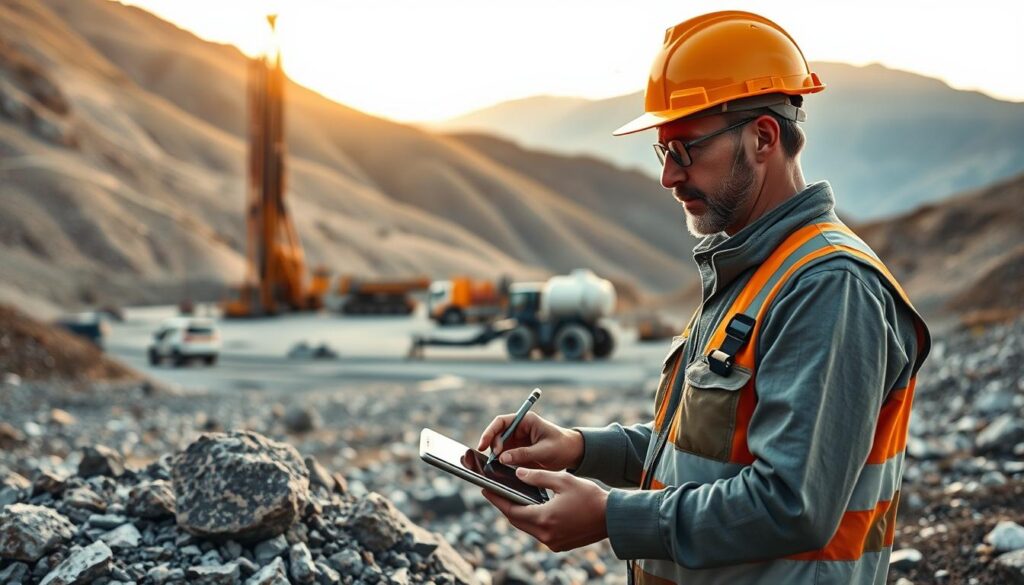
Conclusion: Embarking on Your Mining and Geological Engineering Journey
Mining and Geological Engineering offers a dynamic career path that combines technical expertise with environmental stewardship. As you’ve seen, the field encompasses a broad range of disciplines, from mine design and planning to environmental compliance and mine reclamation.
With the increasing demand for earth materials and the need for sustainable practices, professionals in this field are poised to make a significant impact. Whether you’re involved in site characterization, underground construction, or resource management, your work will contribute to the responsible extraction and utilization of natural resources.
As you consider your career options, remember that Mining and Geological Engineering is a field that offers not only technical challenges but also opportunities for innovation and leadership. By pursuing a career in this exciting field, you’ll be part of a community that is shaping the future of resource management and environmental sustainability.
